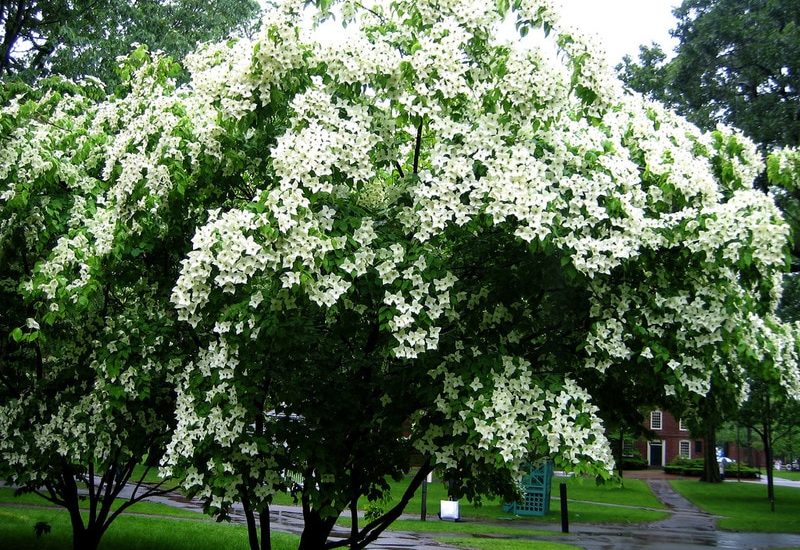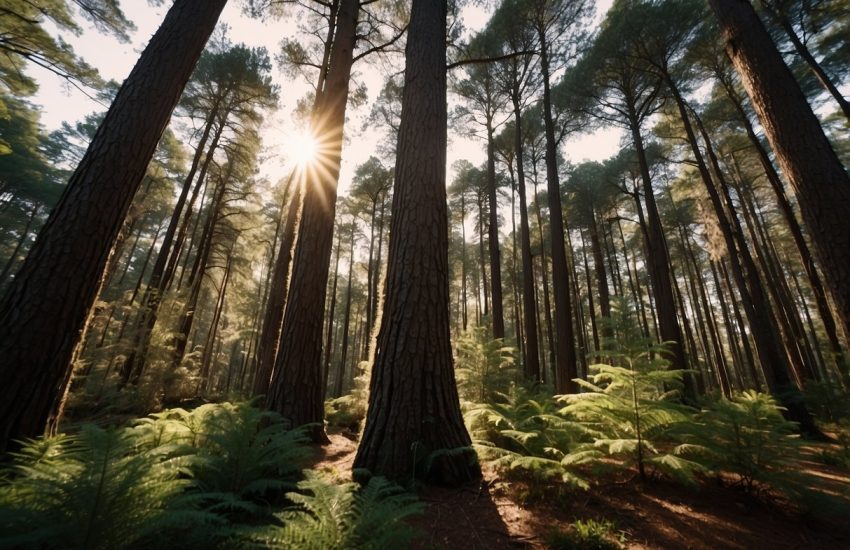The Best Evergreen Trees to Plant in Alabama
When it comes to planting an evergreen tree in Alabama, a gardener or homeowner has many varieties at their disposal. Regardless of which part of the state you reside in, there will be a perfect tree available for you.
A lot of times, the evergreen tree is planted to ensure that privacy is maintained. With that said, let’s take a look at a few evergreen trees that are the best for planting in Alabama.
Loblolly Pine
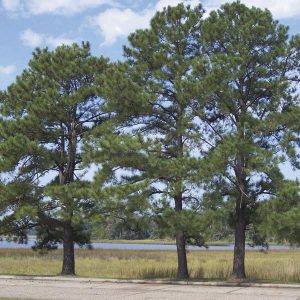
As a gymnosperm, the Loblolly Pine is known to grow at least 60 feet tall. Its shape resembles a pyramid as it grows and grows a crown that is dense and as it matures, the lower branches no longer become useful.The trunk’s thickness can also be as much as 2 feet and the needles can be as long as 8 inches that are usually in clusters.
Over time, the pine’s bark will thicken to form plates that are flakey and irregular and when the bark is removed, the wood will be a dark coloring. During the spring, you will witness both male and female flowers. The male will vary between red and yellow and the female will vary between purple and yellow as they mature. The soil should be more acidic and moist but not be too wet with very little drainage, however a soil that is alkaline will be tolerated. The Loblolly prefers a hot and humid climate during summer months and winters that are mild in nature. Out of all of the pines, the Loblolly is known to grow the fastest.
The Loblolly pine is used heavily for construction purposes and is often turned into plywood or pulp. The Loblolly pine is also great for maintaining forests as it is known to grow fast.
Southern Live Oak
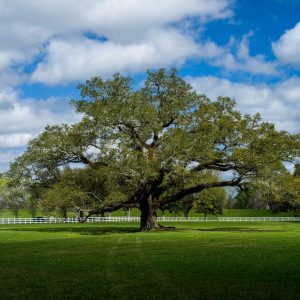
Having impressive beauty makes the southern live oak a great tree to plant in Alabama. With a nice amount of space, its limbs are able to dive down prior to catapulting back up, which brings about a spectacular branch arrangement. Its crown is able to reach more than 145 feet in diameter. However, the average size of the crown can reach more than 80 feet and be as tall as 45 feet.The tree branches stem out from its trunk and can reach a diameter of five feet.
In contrast to other oaks, the southern live oak is considered an evergreen because of it gradually replacing its leaves during spring. The oak produces acorns that are a diet staple for many birds and other wildlife. Not only that, but the scrub jay utilizes the oak scrub to create its nest and the tree moss is also incorporated to make nests.
Yaupon
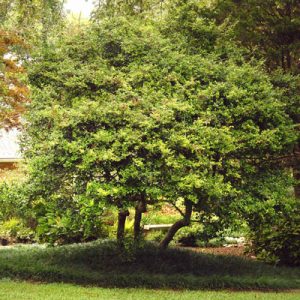
Related to the holly family, the Yaupon grows fast and can be found all throughout the south. Its genus name is llex and displays similar leaves of the holm oak. You can find the yaupon leaves within tea. However, consuming a large quantity can cause vomiting to occur.
The yaupon’s height can easily grow beyond 25 feet and reach an 8 foot width. Both female and male plants are separate and require both to be planted in order to create the tree’s red fruit. For planting, the soil needs to be well-drained and between sun and shade. However, to achieve a thick canopy and increased amount of fruit, it will need a higher amount of sun. Yaupon has a high tolerance to different soils and is able to resist any flooding, drought, and salt sprays. Pruning does not affect the Yaupon and transplanting can be accomplished effortlessly and you do not need to be concerned about root rot. The yaupon will also create thickets if root cuskers do not get pruned.
The small green leaves of the yaupon are bright and leathery and do not prick as opposed to many other types of holly. They also create a nice source of food for butterflies. The flowers bloom in spring and are rich in nectar and very fragrant. The flowers are also separate for female and male trees. During pollen season, butterflies and bees are easily attracted to the beautiful flowers. When pollination takes place, the female trees will make drupes throughout fall and winter. The fruit that is produced then gets eaten by the area wildlife. If pruning is not accomplished, then thickets will form.
Eastern Red Cedar
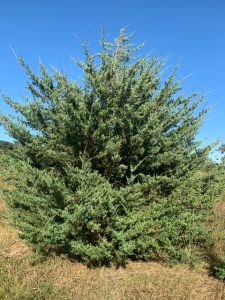
The eastern red cedar tree is able to reach a height of more than 35 feet. Its leaves resemble scales that are glandular and oppressed. The red cedar’s bark consists of a reddish-brown color and sheds in strips. When exposed, the tree becomes gray. The flowers are bluish-green and will finish maturing in spring. The blue fruit produced has a spherical shape and will mature on female cedars during the fall months. The red cedar’s heart-wood is very aromatic and a light brown color as compared to other similar tree species and is highly used for a cedar chest. Besides a chest, the wood is also incorporated into rails and fencing due to its ability to resist rot. The red cedar is also a natural insect repellent, which makes it great for storing clothes.
The soil for the red cedar should have good drainage and not be too dry or wet in complete sun. It can tolerate many conditions and soil types and can be found among rocky areas and swamp water. The red cedar will also do great in soils that are barren. Although the red cedar prefers the soil to be moist, it will not tolerate soils that are wet in a continuous manner. Use of shade is only beneficial while the tree is young and can resist drought longer than any other native conifer.
Transplanting a red cedar is trouble-free and is very dependable and tough although it can be weedy. In order to grow and expand, the space needs to be airy and will provide you with a nice screen or among other cedars. You will find it a lot during the winter as a Christmas tree.
Southern Magnolia
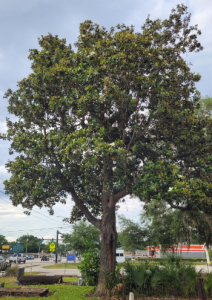
As a large evergreen, the broadleaf southern magnolia has appealing green leaves that are nice and glossy along with flowers that are the most fragrant. In Alabama, you will find it in wooded regions. The southern magnolia is the sole evergreen of its family and can reach a height of at least 60 feet with a crown that ranges between round and pyramid shape. Its width can reach as much as 40 feet and the trunk diameter can be as much as 3 feet. It is believed that the magnolia is among the oldest known species of tree.
If you want a tree that is truly a sight to see, then planting a magnolia will be the way to go. Just make sure that your area is spacious enough for plenty of growth to take place. The branches towards the bottom will usually need to be removed so that the tree has a nicer appearance. When the bottom branches are removed, mulch will need to be placed for erosion to be prevented.
The southern magnolia produces flowers that are white and fragrant during the summer and get used a lot as ornaments. The fruit is brown and woody with red seeds and gets incorporated in a number of uses.
The soil for the magnolia needs to be shaded partially and is normally a low coverage tree, but when used ornamentally, its limbs are always at ground level. The level of moisture can be high for the magnolia, but does not do good if the soil is swampy.
Leyland Cypress
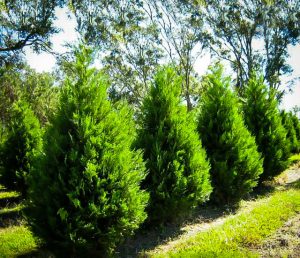
If you are looking to add privacy to your Alabama property, then the leyland cypress is a popular choice. The growth rate is fast so that you can obtain the needed privacy quickly. Along with the fast rate of growth, this cypress will not require very much pruning or maintenance. Many times, when the tree is used in the yard, it is transformed into hedges.
There are many soil and climate types that the cypress tolerates as well as making for a great windshield while maintaining its vibrancy.
Dahoon
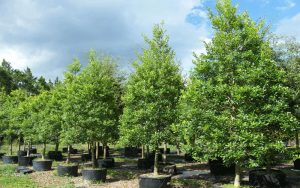
This small tree has one trunk that includes a canopy that varies between a pyramid shape and oval. The dark leaves are at least 2 inches in length and easily resist disease and pests. In order to pollinate, both a female and male tree need to be introduced.
In the spring, the female dahoon produces a flourishing amount of flowers that lead into red berry fruit. When fall comes around, the berries become ripe and remain up until winter hits as long as the wildlife hasn’t eaten them yet. In order to produce berries, the dahoon needs both a male and female tree.
Dahoon’s enjoy a full amount of sun with a little shade and the soil should be wet but not overly damp. It is drought-tolerable and can handle pollution and a little salt. When you are in need of a tree that does not require much maintenance, then the dahoon will suit your needs.
LongLeaf Pine
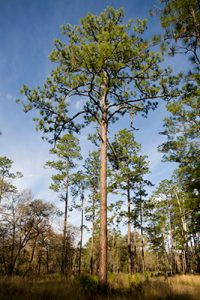
Having a longleaf pine is a nice addition to your Alabama landscaping. It is nice and broad and a habit that is tall and branches that are stout and a crown that is irregular. Its needles can be as long as 15 inches, which no other pine in the area can compare to. They are grouped in three and add a great amount of flexibility. Its cones of the longleaf pine can be at least 6 inches long and can be several years old before falling off. This pine is best for yards that are big in size or making for a great addition to an existing garden display.
During its first 5 years of growth, the longleaf pine will remain small as their taproot is growing. After its taproot is deeply rooted, there will be no need for water and easily handles drainage issues.
The longleaf pine enjoys soil that is rich in acid along with a full amount of sun. Their canopy is also nice and airy.
Slash Pine
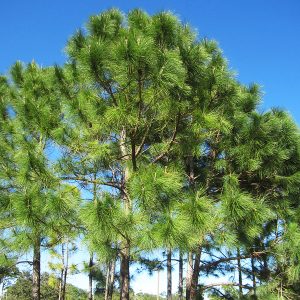
This slender pine is nice and tall with a trunk that is contorted along with a crown that is conical that flattens after it matures. Growth easily takes place near low tides, flatwoods, and infertile sandhill soil. The slash pine has many uses as a lumber due to its rapid growth and strength. Its use is also great in natural areas or in a group setting. Just be aware of its placement because the limbs on the bottom will eventually die.
Italian Cypress
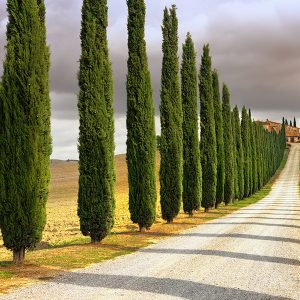
This slim cypress is a delightful evergreen and provides a column shape that stands upright and can be seen in home gardens. This cypress remains a popular option due to their fast growth rate and are able to achieve three feet of growth each year.
Its crown is dense and shaped symmetrically, which helps the tree remain a popular choice. When the conditions are good, their height can reach as tall as 120 feet. However, the majority will only achieve half of that. Once mature, the tree’s bark becomes white. You will need to ensure that the Cypress gets complete sun throughout its life and soil that is either acidic, sandy, clay, or alkaline.
Japanese Cedar
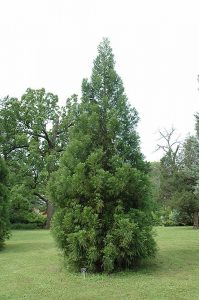
This cedar’s pattern is unusual to say the least and has leaves that are feathery. They are perfect in an individual setting or in groups to offer privacy. They can also grow fast and can achieve a yearly growth rate of 4 feet per year.
Although this cedar is tal, its base is significantly wide and gradually decreases on top. It has soft foliage and is able to provide a nice calming notion as it blows in the wind. It is packed densely and provides an elegant fragrance. The soil type can be any kind and even works well in clay. Planting can take place in partial shade or complete sun and can tolerate drought and is resistant to pests.

